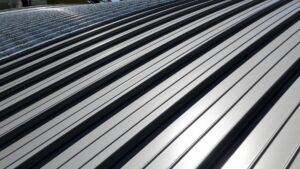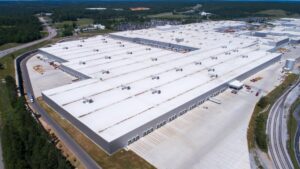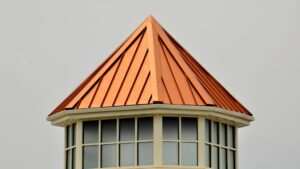Did you know that a commercial flat roof isn’t flat? The size of this slope is usually small, but not zero.
Flat roofs must have slopes or else water can’t drain off them. Even with these slopes, commercial flat roofs might struggle to shake off rainwater. That’s perhaps the biggest disadvantage of a flat roof design.
Still, there are many advantages of commercial flat roofs as well. Read on to learn more about the advantages and disadvantages of a commercial flat roof.
What Is a Commercial Flat Roof?
Officially, the National Roofers Contractors Association classifies a flat roof as a low-slope roof. A commercial flat roof in particular is a type of flat roof that sits atop a commercial building.
Along with having a slope, flat roofs must also have a proper drainage system. Flat roofs can have gutters like steeper roofs. However, some businesses may prefer to install cheap, simple scuppers.
Common Flat Roofing Materials
Materials placed on flat roofs tend to differ from those placed on steeper roofs. Here are some different roofing materials that often appear on flat roofs.
Thermoplastic Polyolefin (TPO)
TPO roofing consists of a single-ply plastic membrane that has a white reflective coating. This white coating easily reflects heat and keeps the building below cool. In addition, this material is very cost-effective and lightweight.
Polyvinyl Chloride (PVC)
PVC membranes are a very popular flat roofing option. When installed properly, they can last for many decades. They’re also resistant to fire, wind, and hail damage.
Modified Bitumen
Modified bitumen is another type of membrane. As it’s made of asphalt, its material is similar to that of three-tab asphalt shingles. However, modified bitumen is a bit more flexible and has a waterproof coating applied.
Built-Up Roofing (BUR)
Roofers who install BUR roofing are installing a few layers of material. Usually, they’ll put down asphalt, boards, gravel, and then more asphalt. While this roofing type is heavy, it stands up well against storms.
Standing Seam Metal
Standing seam metal panels lock together over the tops of roofs. These types of roofs tend to be expensive. However, they can last for around half a century or more, depending on the chosen metal type.
Commercial Flat Roof Advantages
Commercial buildings everywhere have flat roofs. There are many reasons why commercial building owners love them.
Cheap to Install
Commercial building owners with a low roof project budget don’t need to worry. Flat roofs are cheaper than steep roofs to install. Things are this way because roofers tend to use fewer materials to build flat roofs than steep roofs.
Keep in mind, though, that some flat roof materials can get expensive. The previously-mentioned standing seam metal roofing is a good example of this. However, if you’re happy with a TPO, PVC, etc. roof, you shouldn’t break the bank.
Fast Installation Time
Since they’re using fewer materials, roofers also take less time to install flat roofs. This can be a great advantage to commercial building owners.
Any businesses that operate in the building will need to stop their operations during a flat roof installation. Customers will hate the noise and the dust and debris is hazardous. Luckily, businesses won’t need to halt their operations for a long time with a flat roof installation.
Easier to Clean
Flat roofs are more accessible than steep roofs. Their flat surfaces are easy to walk around on. Anyone can walk around on the surface, pick up debris, and clean up mold, water, etc.
It is not a good idea for a non-roofer to walk around on a flat roof. They can still fall off and injure themselves. Plus, walking around on the surface of a roof can cause damage.
If building owners hire experienced roofers to clean a flat roof, though, they’ll finish their work extremely fast. Building owners will then end up having to pay less for per-hour labor costs.
Commercial Flat Roof Disadvantages
However, commercial building owners shouldn’t just jump into a flat commercial roofing project. This roof type has many disadvantages they need to be aware of. By knowing what they’re getting into, commercial building owners can minimize these issues.
Harder to Drain
The shallow angle of a flat roof makes it harder for it to shed rainwater. This can stay on a flat roof for a long time. When it’s there, the water can help mold grow and cause leaks.
There are ways to lessen this disadvantage, though. One thing a building owner can do is to get a more efficient drainage system. An internal drainage system, for instance, is often much more effective than scuppers.
Making the flat roof materials more waterproof is another option. Most roofing companies should have waterproofing chemicals, materials, etc., that they can add to flat roofs.
Vulnerable to Snow Weight
It is possible to install flat roofs in snowy climates. However, many commercial buildings in these areas don’t do this. Snow can accumulate on top of flat roofs and the added weight can cause the roof to collapse.
Luckily, this is an easy fix. Frequent snow removal can prevent the weight of snow from causing a flat roof to collapse. Many roofing services offer this snow removal as part of their extended services.
Get a Flat Roof Installation From Us
In summary, flat roofs are quick and cheap to install and easy to clean. One needs to take care in removing the snow and water that can pile up on this roof. But building owners can easily overcome such issues.
Do you need a commercial flat roof installed in Connecticut, Massachusetts, or Florida? If so, you should contact us at Eagle Rivet Roof Service Corporation. Our award-winning services are sure to give you a commercial flat roof you love.
To get a free roof replacement estimate from us, fill out the form on this page.

David Nietch graduated from Central Connecticut State University with a Bachelor of Science in Business Management and Organization. He has a strong background in positions which require experienced operation and project management as well as a strong attention to detail. David has a profound knowledge of concepts, competitive products, practices and process dealing with the roofing market. David excels at building highly effective working relationships with clients, technicians, managers and vendors.




